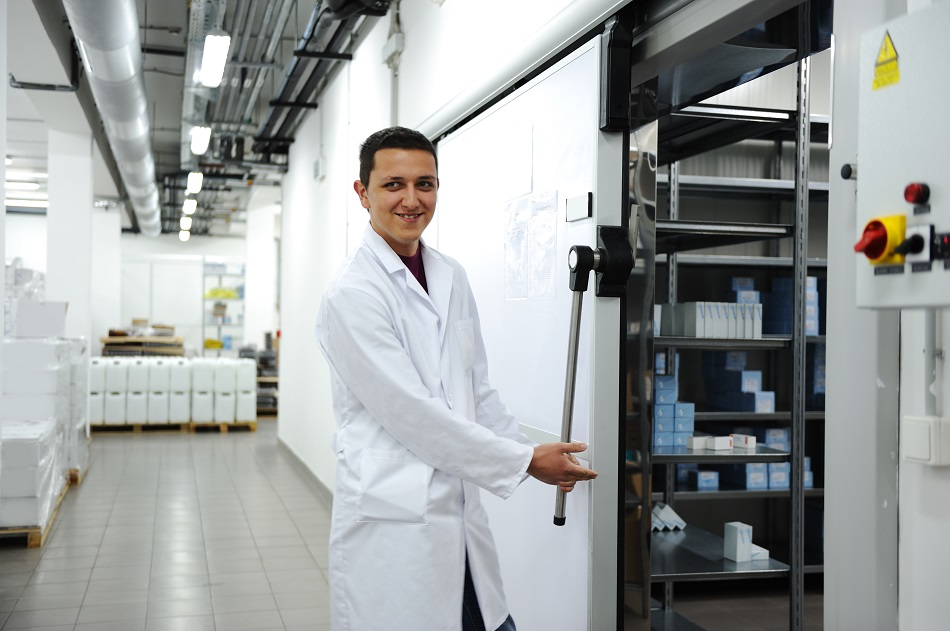Gas safety is a key consideration for any refrigeration application.1 A Mechanical & Electrical (M&E) partner for International Gas Detectors (IGD) required an ammonia detection system for an industrial refrigeration facility.

Image Credits: ESB Professional/Shutterstock.com
Detection of ammonia can be a demanding and complicated task – but IGD was able to offer a solution that fits with their client’s present infrastructure. They provided training on the process of design, commissioning, installation, and ongoing maintenance so that the M&E partner can administer a turnkey gas detection solution. Some of the project’s challenges and solutions IGD faced are outlined in this article.
Typically, refrigeration necessitates the use of refrigerant fluid, and many standard refrigerants – such as propane, carbon dioxide, and ammonia – are dangerous gases at room temperature. For example, where propane is extremely flammable, carbon dioxide and ammonia are both toxic.2,3,4 Therefore, to ensure the safety of personnel in industrial refrigeration applications, dependable gas detectors are vital to safeguard against any leaks.
IGD was approached by one of their M&E partners who had received a request to place a gas detection system at a food refrigeration facility belonging to an international transportation company. The facility, located in Liverpool, is comprised of multiple warehouse-sized chillers and freezers which are employed for the storage of food prior to transportation.
Ordinarily, facilities with industrial refrigeration will follow the European Standard guidelines established in EN 378.5 However, in this instance, the transport company held concerns regarding occupational exposure, subsequent to reports of the smell of gas onsite. To adequately address employee safety concerns (and ensure COSHH safe exposure regulations such as EH40 were met), the client set upon installing gas detectors in the areas where onsite personnel worked.6
The refrigerant gas present onsite is ammonia (NH3): an invisible gas with an acrid smell. Ammonia is frequently used as a refrigerant for numerous reasons, including first-rate heat-absorption properties and its compatibility with smaller-diameter pipes.7 Despite that, ammonia is an irritant and can lead to serious health problems in high concentrations or over long periods of exposure.
Although specific rules are not in place, where the use of ammonia in industrial refrigeration facilities in the UK is concerned (it’s addressed in various Health and Safety at Work regulations), questions over employee wellbeing signified that the client wanted to install a sturdy detection system to guarantee levels of ammonia remained within safe limits.4
The Challenges of Low-Temperature Ammonia Detection
Detecting ammonia at low temperatures can present unique challenges. Ammonia can degrade or “consume” current electrochemical gas detectors.8,9 Over long periods of time smaller, background levels of ammonia can severely impact the sensors which can induce a loss of sensitivity.
This could lead to a potential disaster if a compromised sensor allows a major ammonia leak to go undetected. In most cases, optical sensors are favored for ammonia detection as they don’t experience the same degradation.
However, in this instance, there are application issues to consider: particularly, low temperatures. Numerous electrochemical sensors are only rated to -20 C, and optical sensors suffer at these temperatures due to condensation and icing issues.
IGD developed a solution when met with the difficulties of measuring ammonia at low temperatures, establishing and distributing our line of long-life ammonia sensors based on ionic technology.
This technology is non-consumptive, enabling the sensors to function effectively over long periods without degradation even where there is a continuous presence of ammonia. The technology doesn’t require water in its electrolyte, allowing for a reliably accurate operation down to -40 C. In this specific case, IGD possessed a technological edge over the competition.
The Solution
Typically, in refrigeration applications, the preference is to install gas detectors around the valve stations, as gas tends to leak and amass in this area. However, in this facility, the innovation was that valve stations were positioned outside. Alternatively, IGD recommended gas detectors to be installed near to the entrances and exits of the chillers and freezers – thus, levels of ammonia amassing in these areas were most personnel were working could be sufficiently monitored.
Using IGD’s advanced addressable 2-wire technology, the M&E partners installed gas sensors. This offers a significant advantage over standard addressable systems or 4-20 mA systems in that less wiring is required. In this instance, the ability to use a 2-wire configuration provided savings on installation time of up to 70%.
Ongoing Monitoring
Meeting the client’s requirement to remotely monitor the gas detection system was one of the main challenges with this application. IGD’s M&E partner who installed the system already monitors key systems at the facility using the Resource Data Management platform, and IGD has already developed a Data Management add-on to provide remote monitoring.
IGD’s software division made great efforts to create a Data Management add-on that meets the standards of advanced 2-wire addressable standards so that gas levels can be monitored using the existing RDG system. RDG solutions are now possible for all other gas detection applications, enabling remote monitoring of gas levels.
The client now has a sturdy, precise, and long-lasting gas detection system that seamlessly fits in with their remote process monitoring already in place.
Training and Support for M&Es
Due to their expertise in the field of gas detection, IGD provided complete training for their M&E partner on every stage-element of the design, implementation, and maintenance of gas detection systems.
References and Further Reading
- Gas Detection For Refrigeration and Air Conditioning - Applications- International Gas Detectors : International Gas Detectors. Available at: https://www.internationalgasdetectors.com/applications/gas-detection-for-refrigeration-and-air-conditioning/. (Accessed: 21st July 2020)
- WHO Air quality guidelines for particulate matter, ozone, nitrogen dioxide and sulfur dioxide. (2006).
- Maclaine-Cross, I. L. & Leonardi, E. Performance and Safety of LPG Refrigerants.
- Pearson, A. Refrigeration with ammonia. International Journal of Refrigeration 31, 545–551 (2008).
- Introduction to Refrigeration Standard EN 378.
- EH40/2005 Workplace exposure limits. (2020).
- Ammonia As a Refrigerant: Pros and Cons | Just Venting. Available at: https://www.goodway.com/hvac-blog/2009/08/ammonia-as-a-refrigerant-pros-and-cons/. (Accessed: 21st July 2020)
- Understanding Ammonia Sensors. Available at: https://www.gasalarmsystems.co.uk/news/article/understading_ammonia_sensors. (Accessed: 21st July 2020)
- Ly, T. N. & Park, S. Highly sensitive ammonia sensor for diagnostic purpose using reduced graphene oxide and conductive polymer. Sci. Rep. 8, (2018).

This information has been sourced, reviewed and adapted from materials provided by International Gas Detectors Ltd.
For more information on this source, please visit International Gas Detectors Ltd.